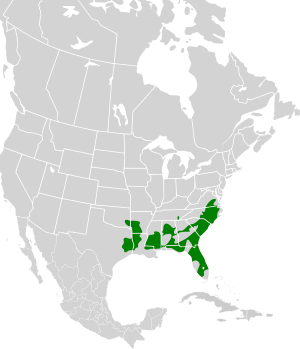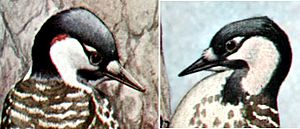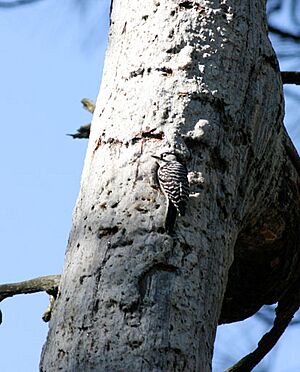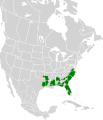Red-cockaded woodpecker facts for kids
Quick facts for kids Red-cockaded woodpecker |
|
|---|---|
 |
|
| Female with insect prey in mouth | |
| Conservation status | |
| Scientific classification | |
| Genus: |
Leuconotopicus
|
| Species: |
borealis
|
 |
|
| Current range | |
| Synonyms | |
|
|
The red-cockaded woodpecker (Dryobates borealis) is a special type of woodpecker that lives only in the southeastern United States. It's known for making its home in living pine trees. This bird is an important part of the forest ecosystem.
Contents
What Does the Red-Cockaded Woodpecker Look Like?
The red-cockaded woodpecker is a small to medium-sized bird. It measures about 18 to 23 centimeters (7 to 9 inches) long. Its wings can spread 34 to 41 centimeters (13 to 16 inches) wide. This woodpecker usually weighs between 40 and 56 grams (1.4 to 2 ounces).
Its back has black and white stripes. A black cap and a black area on its neck surround large white patches on its cheeks. The male woodpecker has a small red streak on each side of its black cap. This red streak is called a cockade, which is how the bird got its name. You can usually only see these red marks during the breeding season. The red-cockaded woodpecker is currently listed as "Near Threatened" by the IUCN.
How Do Red-Cockaded Woodpeckers Live?
Red-cockaded woodpeckers mostly eat insects. Their diet includes ants, beetles, cockroaches, caterpillars, and spiders. They also sometimes eat fruit and berries. They prefer to find food on large pine trees.
Reproduction and Family Life
These woodpeckers are very territorial and do not migrate. They often stay with the same mate for many years. They are also known for their "cooperative breeding" style. This means other birds in the group help raise the young.
The nesting season is from April to June. The female bird lays three to four small white eggs. These eggs are laid in a special hole, called a roost cavity, made by the male. All the birds in the group help keep the eggs warm for 10 to 13 days.
Once the chicks hatch, they stay in the nest for about 26 to 29 days. After they can fly, the young birds often stay with their parents. They form groups that can have up to nine or more members, but usually have three or four. Only one pair of birds in the group breeds each year. The other group members, often young males from the year before, help take care of the eggs and chicks. Young females usually leave the group to find their own mates. The main threats to young woodpeckers in their nests are rat snakes and corn snakes.
Where Do Red-Cockaded Woodpeckers Live?
Historically, these woodpeckers lived across the southeastern United States. Their range stretched from Florida to New Jersey and Maryland. It went as far west as eastern Texas and Oklahoma. They were also found inland in Missouri, Kentucky, and Tennessee.
Today, there are about 5,000 groups of red-cockaded woodpeckers. This means there are about 12,500 birds in total. They live from Florida to Virginia and west to southeast Oklahoma and eastern Texas. This is only about 1% of their original population. They are no longer found in Kentucky, Maryland, Missouri, New Jersey, and Tennessee.
Their Special Pine Tree Homes
The red-cockaded woodpecker lives in pine savannas that often have natural fires. They especially like Longleaf pines (Pinus palustris). Unlike other woodpeckers that dig holes in dead, soft wood, the red-cockaded woodpecker is unique. It digs its homes only in living pine trees.
Older pine trees that these woodpeckers prefer often have a fungal infection. This infection is called red heart rot. It makes the center of the tree trunk, called the heartwood, soft. It usually takes 1 to 3 years for the woodpeckers to dig out a cavity.
A group of cavity trees is called a cluster. A cluster can have 1 to 20 or more cavity trees. These clusters can cover 3 to 60 acres. The average cluster is about 10 acres. Active cavity trees have many small holes that leak sap. The birds keep the sap flowing. This sap acts like a defense against rat snakes and other animals that might try to get into their nests.
A group's territory usually ranges from 125 to 200 acres. However, some territories can be as small as 60 acres or as large as 600 acres. The size of their territory depends on how good the habitat is and how many woodpeckers live nearby. If there are too many woodpeckers, they spend more time defending their territory. This can mean they have less time to find food or raise their young.
Why Their Cavities Are Important
The red-cockaded woodpecker plays a very important role in the southern pine forests. Many other birds and small mammals use the holes these woodpeckers create. These include chickadees, bluebirds, titmice, and other woodpecker species. Even larger woodpeckers like the northern flicker or pileated woodpecker might take over a red-cockaded woodpecker's cavity. They sometimes make the hole bigger.
Once the holes are larger, other animals can move in. These include eastern screech owls, wood ducks, and even raccoons. Flying squirrels, different kinds of reptiles and amphibians, and insects like bees and wasps also use these cavities.
Protecting the Red-Cockaded Woodpecker
The red-cockaded woodpecker faces challenges when its pine homes are removed. When a large group of birds gets separated, it becomes hard for young birds to find mates. This makes it difficult for the species to spread to new areas. When they search for new places to live, they often find habitats where other woodpecker species compete with them. For example, the pileated woodpecker is known to make the red-cockaded woodpecker's cavities wider, which makes them unusable for the smaller bird.
Conservation efforts for the red-cockaded woodpecker began even before the Endangered Species Act was passed in 1973. In Florida, some birds are being released into new areas to help their numbers grow.
Helping Create Homes
Since nesting spots are so important for these woodpeckers, a lot of effort goes into creating more ideal nesting sites. Areas with nesting clusters are protected from logging. This helps save the old, large trees they need. The nesting sites themselves are also managed to make them more attractive.
One method used is controlled burning. This helps reduce other plants that grow around the nesting areas. Red-cockaded woodpeckers prefer nesting sites with fewer other plants. However, controlled burning must be done carefully. This is because the sap that the woodpeckers use as a barrier is very flammable.
States like Texas, Louisiana, Alabama, and Georgia are creating artificial cavities in Longleaf Pine trees. Wildlife managers use two main ways to do this. The most common way is to carve out a nesting hole in the tree and insert a ready-made nest. An older method is to drill a hole into the tree, hoping the birds will use it.
Digging new cavities takes a lot of energy for the woodpeckers. So, they often spend more energy competing for existing homes. They will use artificial cavities and even return to old, abandoned areas if new cavities are made there.
Protecting Existing Cavities
Another way to help is by protecting the existing cavities. The most common method is using a restrictor plate. This plate prevents other species from making the cavity entrance larger or changing its shape. These plates must be checked regularly. This makes sure they don't block the woodpecker and are adjusted as the tree grows.
Challenges with Landowners
Under the Endangered Species Act, private landowners are not allowed to change habitats or harm animals that are protected. In some areas, like Eastern Texas, some landowners have cut down Longleaf pine trees. They do this to prevent the woodpeckers from nesting on their land. By removing the trees, landowners can avoid having to follow rules from the U.S. Fish and Wildlife Service. This allows them to use their property as they wish without restrictions related to protecting the endangered species.
Images for kids
See also
 In Spanish: Pico de Florida para niños
In Spanish: Pico de Florida para niños








